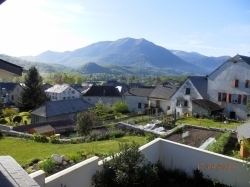Canton Arudy | Intercommunality Vallée d'Ossau | |
 | ||
Arudy (Gascon: Arudi) is a French commune in the Pyrénées-Atlantiques department in the Nouvelle-Aquitaine region of south-western France.
Contents
- Map of 64260 Arudy France
- Geography
- Hydrography
- Toponymy
- History
- Administration
- Inter communality
- Demography
- Economy
- Civil heritage
- Environmental heritage
- Education
- Sports and sports facilities
- Notable people linked to the commune
- References
Map of 64260 Arudy, France
The inhabitants of the commune are known as Arudyens or Arudyennes.
The commune has been awarded one flower by the National Council of Towns and Villages in Bloom in the Competition of cities and villages in Bloom.
Geography
Arudy is located in the Ossau Valley on a bend on the Gave d'Ossau some 20 km south-east of Oloron-Sainte-Marie and 16 km south of Gan. Access to the commune is by the D920 road from Buzy in the north passing through the commune just west of the town and continuing to Louvie-Juzon in the south. Access to the town is by the D53 connecting to the D920. The D287 also goes east from the town to join the D934 going north to Sévignacq-Meyracq. The D918 branches west from the D920 near the town and continues west through the north of the commune to Lurbe-Saint-Christau.
The SNCF railway line from Buzy-en-Béarn - Laruns which passed through the commune was closed to traffic for passengers on 2 March 1969. A bus connection remained in place until 1 September 2009. Freight traffic between Buzy-en-Béarn and Arudy survived until 2003. The facilities have now been dismantled.
The western hills of the commune are heavily forested with farmland in the valleys. The east of the commune in the Ossau Valley is mainly residential with some farmland.
Hydrography
Located in the Drainage basin of the Adour, the Gave d'Ossau forms the eastern border as it curves around the town and continues west, forming the northern border of the commune, to join the Gave d'Aspe to form the Gave d'Oloron at Oloron-Sainte-Marie. Many tributaries rise in the south of the commune and flow north to join the Gave d'Ossau including the Lamisou, the Arrec de Baycabe, the Ruisseau du Bois de Nougué, the Arrec de Lacerbelle, and the Ruisseau du Termy which forms the western border of the commune.
Toponymy
The commune name in béarnais is Arudi.
According to Michel Grosclaude the name comes from the basque harr ("stone" or "rock") and uri ("town").
The following table details the origins of the commune name and other names in the commune.
Sources:
Origins:
History
The first traces of civilisation in the commune date to Prehistory or more precisely to the Magdalenian period. Excavations in four caves in the commune (Maladore, Poeymaü, Saint-Michel, and Espalungue) uncovered bones, tools, and many snail shells.
The village of Eruri or Aruri was mentioned at the beginning of the 13th century. It was from the beginning of that time that the Ossau Union was created which permitted relative independence for the communes in the valley until the French Revolution.
Paul Raymond noted on page 14 of his 1863 disctionary that the commune had a Lay Abbey, vassal of the Viscounts of Béarn, with 86 fires and depended on the bailiwick of Ossau.
It was in the 19th century that economic growth started in the commune. Sawmills and Marble quarries were created which provided a living to several hundred people. One quarry still operates today.
On 29 February 1980 Arudy was the epicentre of an earthquake measuring 5.2 on the Richter scale and 7.5 on the MSK scale which damaged many buildings in the town. The college had to be rebuilt.
Administration
List of Successive Mayors
(Not all data is known)
Inter-communality
The commune is part of six inter-communal structures:
Demography
In 2010 the commune had 2,230 inhabitants. The evolution of the number of inhabitants is known from the population censuses conducted in the commune since 1793. From the 21st century, a census of communes with fewer than 10,000 inhabitants is held every five years, unlike larger towns that have a sample survey every year.
Sources : Ldh/EHESS/Cassini until 1962, INSEE database from 1968 (population without double counting and municipal population from 2006)
Economy
Arudy has diverse economic activities:
Civil heritage
The Hôtel Pouts (17th century) is registered as an historical monument. It is an ancient Lay Abbey which later became a police station. The building was renovated in 1971 to house a museum: the Maison d'Ossau.
The Maison d'Ossau museum in the Hôtel Pouts displays regional archaeological collections, specimens of flora and fauna of the Pyrenees, and local costumes.
Arudy has 16th and 17th century houses, a bridge said to be Roman, and Lavoirs (public laundries) from the 19th century.
The Church of Saint-Germain (12th century, renovated in the 19th century) contains several items classified as historical objects:
The interior of the chapel of Saint-Michel is decorated with paintings by Pierre Martinez.
Environmental heritage
The Abétat peaks at 1204 metres, the Gerbadure at 1254m, the Soum Counée at 1361m, the Bersaut at 1368m, the Hourquettes de Baygrand at 1386m, the Senzouens (or the Breque) at 1392m, and the Pic d'Escurets at 1440m.
Education
The town has a public college, and one primary school. Another private primary school has been closed since the beginning of September 2011.
